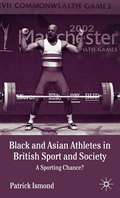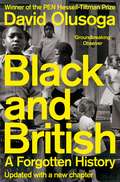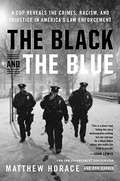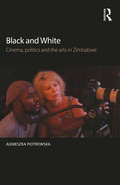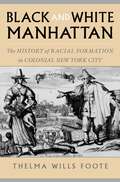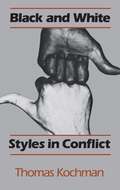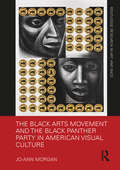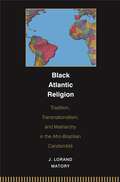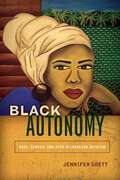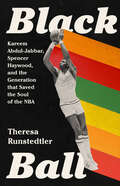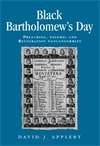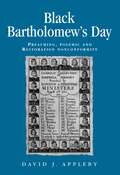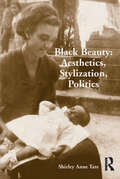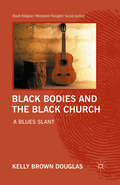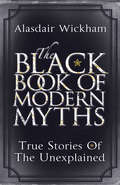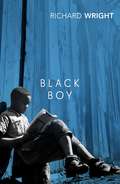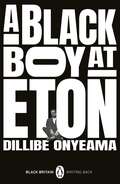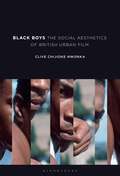- Table View
- List View
Black and Asian Athletes in British Sport and Society: A Sporting Chance?
by P. IsmondIn this innovative study, Patrick Ismond provides an analysis of the issue of racism within British sport. It presents a number of theoretical positions regarding race, racism and sport, before providing a background history of the involvement of minority ethnic communities. Much detailed primary research is used to inform interesting discussions concerning racism in sport and its relationship to ethnicity, identity and notions of Englishness and Britishness. The study also includes a valuable analysis of sexism in sport, and the discrimination suffered by minority ethnic sportswomen.
Black and British: A Forgotten History
by David OlusogaWinner of the 2017 PEN Hessell-Tiltman Prize.Winner of the Longman History Today Trustees' Award.A Waterstones.com History Book of the Year.Longlisted for the Orwell Prize.Shortlisted for the inaugural Jhalak Prize.In this vital re-examination of a shared history, historian and broadcaster David Olusoga tells the rich and revealing story of the long relationship between the British Isles and the people of Africa and the Caribbean. Drawing on new genealogical research, original records, and expert testimony, Black and British reaches back to Roman Britain, the medieval imagination, Elizabethan ‘blackamoors’ and the global slave-trading empire. It shows that the great industrial boom of the nineteenth century was built on American slavery, and that black Britons fought at Trafalgar and in the trenches of both World Wars. Black British history is woven into the cultural and economic histories of the nation. It is not a singular history, but one that belongs to us all.Unflinching, confronting taboos and revealing hitherto unknown scandals, Olusoga describes how the lives of black and white Britons have been entwined for centuries.
The Black and the Blue: A Cop Reveals The Crimes, Racism, And Injustice In America's Law Enforcement
by Matthew Horace Ron HarrisDuring his 28-year career, Matthew Horace rose through the ranks from a police officer working the beat to a federal agent working criminal cases in some of the toughest communities in America to a highly decorated federal law enforcement executive managing high-profile investigations nationwide. Yet it was not until seven years into his service- when Horace found himself face down on the ground with a gun pointed at his head by a white fellow officer-that he fully understood the racism seething within America's police departments. Through gut-wrenching reportage, on-the-ground research, and personal accounts from interviews with police and government officials around the country, Horace presents an insider's examination of archaic police tactics. He dissects some of the nation's most highly publicized police shootings and communities to explain how these systems and tactics have hurt the people they serve, revealing the mistakes that have stoked racist policing, sky-high incarceration rates, and an epidemic of violence.
Black and White: Cinema, politics and the arts in Zimbabwe
by Agnieszka PiotrowskaIn Black and White Agnieszka Piotrowska presents a unique insight into the contemporary arts scene in Zimbabwe – an area that has received very limited coverage in research and the media. The book combines theory with literature, film, politics and culture and takes a psychosocial and psychoanalytic perspective to achieve a truly interdisciplinary analysis. Piotrowska focuses in particular on the Harare International Festival of the Arts (HIFA) as well as the cinema, featuring the work of Rumbi Katedza and Joe Njagu. Her personal experience of time spent in Harare, working in collaborative relationships with Zimbabwean artists and filmmakers, informs the book throughout. It features examples of their creative work on the ground and examines the impact it has had on the community and the local media. Piotrowska uses her experiences to analyse concepts of trauma and post-colonialism in Zimbabwe and interrogates her position as a stranger there, questioning patriarchal notions of belonging and authority. Black and White also presents a different perspective on convergences in the work of Doris Lessing and iconic Zimbabwean writer Dambudzo Marechera, and how it might be relevant to contemporary race relations. Black and White will be intriguing reading for psychoanalysts, psychotherapists and psychotherapeutically engaged scholars, film makers, academics and students of post-colonial studies, film studies, cultural studies, psychosocial studies and applied philosophy.
Black and White: Cinema, politics and the arts in Zimbabwe
by Agnieszka PiotrowskaIn Black and White Agnieszka Piotrowska presents a unique insight into the contemporary arts scene in Zimbabwe – an area that has received very limited coverage in research and the media. The book combines theory with literature, film, politics and culture and takes a psychosocial and psychoanalytic perspective to achieve a truly interdisciplinary analysis. Piotrowska focuses in particular on the Harare International Festival of the Arts (HIFA) as well as the cinema, featuring the work of Rumbi Katedza and Joe Njagu. Her personal experience of time spent in Harare, working in collaborative relationships with Zimbabwean artists and filmmakers, informs the book throughout. It features examples of their creative work on the ground and examines the impact it has had on the community and the local media. Piotrowska uses her experiences to analyse concepts of trauma and post-colonialism in Zimbabwe and interrogates her position as a stranger there, questioning patriarchal notions of belonging and authority. Black and White also presents a different perspective on convergences in the work of Doris Lessing and iconic Zimbabwean writer Dambudzo Marechera, and how it might be relevant to contemporary race relations. Black and White will be intriguing reading for psychoanalysts, psychotherapists and psychotherapeutically engaged scholars, film makers, academics and students of post-colonial studies, film studies, cultural studies, psychosocial studies and applied philosophy.
Black and White Manhattan: The History of Racial Formation in Colonial New York City
by Thelma Wills FooteRace first emerged as an important ingredient of New York City's melting pot when it was known as New Amsterdam and was a fledgling colonial outpost on the North American frontier. Thelma Wills Foote details the arrival of the first immigrants, including African slaves, and traces encounters between the town's inhabitants of African, European, and Native American descent, showing how racial domination became key to the building of the settler colony at the tip of Manhattan Island. During the colonial era, the art of governing the city's diverse and factious population, Foote reveals, involved the subordination of confessional, linguistic, and social antagonisms to binary racial difference. Foote investigates everyday formations of race in slaveowning households, on the colonial city's streets, at its docks, taverns, and marketplaces, and in the adjacent farming districts. Even though the northern colonial port town afforded a space for black resistance, that setting did not, Foote argues, effectively undermine the city's institution of black slavery. This history of New York City demonstrates that the process of racial formation and the mechanisms of racial domination were central to the northern colonial experience and to the founding of the United States.
Black and White Styles in Conflict
by Thomas Kochman"Goes a long way toward showing a lay audience the value, integrity, and aesthetic sensibility of black culture, and moreover the conflicts which arise when its values are treated as deviant version of majority ones."—Marjorie Harness Goodwin, American Ethnologist
Black and White Styles in Conflict
by Thomas Kochman"Goes a long way toward showing a lay audience the value, integrity, and aesthetic sensibility of black culture, and moreover the conflicts which arise when its values are treated as deviant version of majority ones."—Marjorie Harness Goodwin, American Ethnologist
Black and White Styles in Conflict
by Thomas Kochman"Goes a long way toward showing a lay audience the value, integrity, and aesthetic sensibility of black culture, and moreover the conflicts which arise when its values are treated as deviant version of majority ones."—Marjorie Harness Goodwin, American Ethnologist
Black and White Styles in Conflict
by Thomas Kochman"Goes a long way toward showing a lay audience the value, integrity, and aesthetic sensibility of black culture, and moreover the conflicts which arise when its values are treated as deviant version of majority ones."—Marjorie Harness Goodwin, American Ethnologist
The Black Arts Movement and the Black Panther Party in American Visual Culture (Routledge Research in Art and Race)
by Jo-Ann MorganThis book examines a range of visual expressions of Black Power across American art and popular culture from 1965 through 1972. It begins with case studies of artist groups, including Spiral, OBAC and AfriCOBRA, who began questioning Western aesthetic traditions and created work that honored leaders, affirmed African American culture, and embraced an African lineage. Also showcased is an Oakland Museum exhibition of 1968 called "New Perspectives in Black Art," as a way to consider if Black Panther Party activities in the neighborhood might have impacted local artists’ work. The concluding chapters concentrate on the relationship between selected Black Panther Party members and visual culture, focusing on how they were covered by the mainstream press, and how they self-represented to promote Party doctrine and agendas.
The Black Arts Movement and the Black Panther Party in American Visual Culture (Routledge Research in Art and Race)
by Jo-Ann MorganThis book examines a range of visual expressions of Black Power across American art and popular culture from 1965 through 1972. It begins with case studies of artist groups, including Spiral, OBAC and AfriCOBRA, who began questioning Western aesthetic traditions and created work that honored leaders, affirmed African American culture, and embraced an African lineage. Also showcased is an Oakland Museum exhibition of 1968 called "New Perspectives in Black Art," as a way to consider if Black Panther Party activities in the neighborhood might have impacted local artists’ work. The concluding chapters concentrate on the relationship between selected Black Panther Party members and visual culture, focusing on how they were covered by the mainstream press, and how they self-represented to promote Party doctrine and agendas.
Black Atlantic Religion: Tradition, Transnationalism, and Matriarchy in the Afro-Brazilian Candomblé
by J. MatoryBlack Atlantic Religion illuminates the mutual transformation of African and African-American cultures, highlighting the example of the Afro-Brazilian Candomblé religion. This book contests both the recent conviction that transnationalism is new and the long-held supposition that African culture endures in the Americas only among the poorest and most isolated of black populations. In fact, African culture in the Americas has most flourished among the urban and the prosperous, who, through travel, commerce, and literacy, were well exposed to other cultures. Their embrace of African religion is less a "survival," or inert residue of the African past, than a strategic choice in their circum-Atlantic, multicultural world. With counterparts in Nigeria, the Benin Republic, Haiti, Cuba, Trinidad, and the United States, Candomblé is a religion of spirit possession, dance, healing, and blood sacrifice. Most surprising to those who imagine Candomblé and other such religions as the products of anonymous folk memory is the fact that some of this religion's towering leaders and priests have been either well-traveled writers or merchants, whose stake in African-inspired religion was as much commercial as spiritual. Morever, they influenced Africa as much as Brazil. Thus, for centuries, Candomblé and its counterparts have stood at the crux of enormous transnational forces. Vividly combining history and ethnography, Matory spotlights a so-called "folk" religion defined not by its closure or internal homogeneity but by the diversity of its connections to classes and places often far away. Black Atlantic Religion sets a new standard for the study of transnationalism in its subaltern and often ancient manifestations.
Black Atlantic Religion: Tradition, Transnationalism, and Matriarchy in the Afro-Brazilian Candomblé
by J. Lorand MatoryBlack Atlantic Religion illuminates the mutual transformation of African and African-American cultures, highlighting the example of the Afro-Brazilian Candomblé religion. This book contests both the recent conviction that transnationalism is new and the long-held supposition that African culture endures in the Americas only among the poorest and most isolated of black populations. In fact, African culture in the Americas has most flourished among the urban and the prosperous, who, through travel, commerce, and literacy, were well exposed to other cultures. Their embrace of African religion is less a "survival," or inert residue of the African past, than a strategic choice in their circum-Atlantic, multicultural world. With counterparts in Nigeria, the Benin Republic, Haiti, Cuba, Trinidad, and the United States, Candomblé is a religion of spirit possession, dance, healing, and blood sacrifice. Most surprising to those who imagine Candomblé and other such religions as the products of anonymous folk memory is the fact that some of this religion's towering leaders and priests have been either well-traveled writers or merchants, whose stake in African-inspired religion was as much commercial as spiritual. Morever, they influenced Africa as much as Brazil. Thus, for centuries, Candomblé and its counterparts have stood at the crux of enormous transnational forces. Vividly combining history and ethnography, Matory spotlights a so-called "folk" religion defined not by its closure or internal homogeneity but by the diversity of its connections to classes and places often far away. Black Atlantic Religion sets a new standard for the study of transnationalism in its subaltern and often ancient manifestations.
Black Autonomy: Race, Gender, and Afro-Nicaraguan Activism
by Jennifer GoettDecades after the first multicultural reforms were introduced in Latin America, Afrodescendant people from the region are still disproportionately impoverished, underserved, policed, and incarcerated. In Nicaragua, Afrodescendants have mobilized to confront this state of siege through the politics of black autonomy. For women and men grappling with postwar violence, black autonomy has its own cultural meanings as a political aspiration and a way of crafting selfhood and solidarity. Jennifer Goett's ethnography examines the race and gender politics of activism for autonomous rights in an Afrodescendant. Creole community in Nicaragua. Weaving together fifteen years of research, Black Autonomy follows this community-based movement from its inception in the late 1990s to its realization as an autonomous territory in 2009 and beyond. Goett argues that despite significant gains in multicultural recognition, Afro-Nicaraguan Creoles continue to grapple with the day-to-day violence of capitalist intensification, racialized policing, and drug war militarization in their territories. Activists have responded by adopting a politics of autonomy based on race pride, territoriality, self-determination, and self-defense. Black Autonomy shows how this political radicalism is rooted in African diasporic identification and gendered cultural practices that women and men use to assert control over their bodies, labor, and spaces in an atmosphere of violence.
Black Ball: Kareem Abdul-Jabbar, Spencer Haywood, and the Generation that Saved the Soul of the NBA
by Theresa RunstedtlerA vital narrative history of 1970s pro basketball, and the Black players who shaped the NBA Against a backdrop of ongoing resistance to racial desegregation and strident calls for Black Power, the NBA in the 1970s embodied the nation&’s imagined descent into disorder. A new generation of Black players entered the league then, among them Kareem Abdul-Jabbar and Spencer Haywood, and the press and public were quick to blame this cohort for the supposed decline of pro basketball, citing drugs, violence, and greed. Basketball became a symbol for post-civil rights America: the rules had changed, allowing more Black people onto the playing field, and now they were ruining everything. Enter Black Ball, a gripping history and corrective in which scholar Theresa Runstedtler expertly rewrites basketball&’s &“Dark Ages.&” Weaving together a deep knowledge of the game with incisive social analysis, Dr. Runstedtler argues that this much-maligned period was pivotal to the rise of the modern-day NBA. Black players introduced an improvisational style derived from the playground courts of their neighborhoods. They also challenged the team owners&’ autocratic power, garnering higher salaries and increased agency. Their skills, style, and savvy laid the foundation for the global popularity and profitability of the league we know today.
Black Bartholomew's Day: Preaching, polemic and Restoration nonconformity (PDF) (Politics, Culture and Society in Early Modern Britain)
by David ApplebyBlack Bartholomew's Day explores the religious, political and cultural implications of a collision of highly-charged polemic prompted by the mass ejection of Puritan ministers from the Church of England in 1662. It is the first in-depth study of this heated exchange, centres centring on the departing ministers' farewell sermons. Many of these valedictions, delivered by hundreds of dissenting preachers in the weeks before Bartholomew's Day, would be illegally printed and widely distributed, provoking a furious response from government officials, magistrates and bishops. Black Bartholomew's Day re-interprets the political significance of ostensibly moderate Puritan clergy, arguing that their preaching posed a credible threat to the restored political order This book is aimed at readers interested in historicism, religion, nonconformity, print culture and the political potential of preaching in Restoration England.
Black Bartholomew's Day: Preaching, polemic and Restoration nonconformity (Politics, Culture and Society in Early Modern Britain)
by David ApplebyBlack Bartholomew's Day explores the religious, political and cultural implications of a collision of highly-charged polemic prompted by the mass ejection of Puritan ministers from the Church of England in 1662. It is the first in-depth study of this heated exchange, centres centring on the departing ministers' farewell sermons. Many of these valedictions, delivered by hundreds of dissenting preachers in the weeks before Bartholomew's Day, would be illegally printed and widely distributed, provoking a furious response from government officials, magistrates and bishops. Black Bartholomew's Day re-interprets the political significance of ostensibly moderate Puritan clergy, arguing that their preaching posed a credible threat to the restored political order This book is aimed at readers interested in historicism, religion, nonconformity, print culture and the political potential of preaching in Restoration England.
Black Beauty: Aesthetics, Stylization, Politics
by Shirley Anne TatePrevious work discussing Black beauty has tended to concentrate on Black women's search for white beauty as a consequence of racialization. Without denying either the continuation of such aesthetics or their enduring power, this book uncovers the cracks in this hegemonic Black beauty. Drawing on detailed ethnographic research amongst British women of Caribbean heritage, this volume pursues a broad discussion of beauty within the Black diaspora contexts of the Caribbean, the UK, the United States and Latin America through different historical periods to the present day. With a unique exploration of beauty, race and identity politics, the author reveals how Black women themselves speak about, negotiate, inhabit, work on and perform Black beauty. As such, it will appeal not only to sociologists, but anyone working in the fields of race, ethnicity and post-colonial thought, feminism and the sociology of the body.
Black Beauty: Aesthetics, Stylization, Politics
by Shirley Anne TatePrevious work discussing Black beauty has tended to concentrate on Black women's search for white beauty as a consequence of racialization. Without denying either the continuation of such aesthetics or their enduring power, this book uncovers the cracks in this hegemonic Black beauty. Drawing on detailed ethnographic research amongst British women of Caribbean heritage, this volume pursues a broad discussion of beauty within the Black diaspora contexts of the Caribbean, the UK, the United States and Latin America through different historical periods to the present day. With a unique exploration of beauty, race and identity politics, the author reveals how Black women themselves speak about, negotiate, inhabit, work on and perform Black beauty. As such, it will appeal not only to sociologists, but anyone working in the fields of race, ethnicity and post-colonial thought, feminism and the sociology of the body.
Black Bodies and the Black Church: A Blues Slant (Black Religion/Womanist Thought/Social Justice)
by Kelly Brown DouglasBlues is absolutely vital to black theological reflection and to the black church's existence. In Black Bodies and the Black Church , author Kelly Douglas Brown develops a blues crossroad theology, which allows the black church to remain true to itself and relevant in black lives.
The Black Book of Modern Myths: True Stories of the Unexplained
by Alasdair WickhamTHE SUPERNATURAL IS EVERYWHEREIn your home, on the street, in the countryside, around the world:In Denmark, the ghost of the White Lady, who freezes her quarry with an intense chill.In Germany, a succubus, who seduces and devours its prey.In New Zealand, the ghost of a murdered girl, who scrabbles and scratches at a cubicle wall.In Japan, the sea-dwelling Kappa, who drags young children into the icy depths.In Chile, the Chupacabra, a supernatural creature who kills in our world, before leaving for another.In the UK, Satanic cults inhabit the Cornish countryside, awaiting their next unsuspecting victim.No longer can we ignore the signs. Enter the Black Book if you dare to believe.
Black Boy (P. S. Series)
by Richard Wright'In Black Boy I found expressed, for the first time in my life, the sorrow, the rage, and the murderous bitterness which was eating up my life and lives of those around me. [Richard Wright's] work was an immense liberation and revelation for me. He became my ally and my witness, and alas! my father' - James BaldwinAt four years of age, Richard Wright set fire to his home; at five his father deserted the family; by six Richard was - temporarily - an alcoholic. Moved from home to home, from brick tenement to orphanage, he had had, by the age of twelve, only one year's formal education. It was in saloons, railroad yards and streets that he learned the facts about life under white subjection, about fear, hunger and hatred. Gradually he learned to play Jim Crow in order to survive in a world of white hostility, secretly satisfying his craving for books and knowledge until the time came when he could follow his dream of justice and opportunity in the north.
A Black Boy at Eton (Black Britain: Writing Back)
by Dillibe Onyeama'The story [Onyeama] had to tell was so gripping and shocking, it wouldn't let me go . . . A remarkably well-written memoir' Bernardine Evaristo, from the IntroductionDillibe was the second black boy to study at Eton - joining in 1965 - and the first to complete his education there. Written at just 21, this is a deeply personal, revelatory account of the racism he endured during his time as a student at the prestigious institution. He tells in vivid detail of his own background as the son of a Nigerian judge at the International Court of Justice at The Hague, of his arrival at the school, of the curriculum, of his reception by other boys (and masters), and of his punishments. He tells, too, of the cruel racial prejudice and his reactions to it, and of the alienation and stereotyping he faced at such a young age. A Black Boy at Eton is a searing, ground-breaking book displaying the deep psychological effects of colonialism and racism.A title in the Black Britain: Writing Back series - selected by Booker Prize-winning author Bernardine Evaristo, this series rediscovers and celebrates pioneering books depicting black Britain that remap the nation.
Black Boys: The Social Aesthetics of British Urban Film
by Clive Chijioke NwonkaIn Black Boys: The Aesthetics of British Urban Film, Nwonka offers the first dedicated analysis of Black British urban cinematic and televisual representation as a textual encounter with Blackness, masculinity and urban identity where the generic construction of images and narratives of Black urbanity is informed by the (un)knowable allure of Black urban Otherness. Foregrounding the textual Black urban identity as a historical formation, and drawing on a range of theoretical frameworks that allow for an examination of the emergence and continued social, cultural and industrial investment in the fictitious and non-fictitious images of Black urban identities and geographies, Nwonka convenes a dialogue between the disciplines of Film and Television Studies, Philosophy, Cultural Studies, Black Studies, Sociology and Criminology. Here, Nwonka ventures beyond what can be understood as the perennial and simplistic optic of racial stereotype in order to advance a more expansive reading of the Black British urban text as the outcome of a complex conjunctural interaction between social phenomena, cultural policy, political discourse and the continuously shifting politics of Black representation. Through the analysis of a number of texts and political and socio-cultural moments, Nwonka identifies Black urban textuality as conditioned by a bidirectionality rooted in historical and contemporary questions of race, racism and anti-Blackness but equally attentive to the social dynamics that render the screen as a site of Black recognition, authorship and authenticity. Analysed in the context of realism, social and political allegory, urban multiculture, Black corporeality and racial, gender and sexual politics, in integrating such considerations into the fabrics of a thematic reading of the Black urban text and through the writings of Stuart Hall, Paul Gilroy, Judith Butler and Derrida, Black Boys presents a critical rethinking of the contextual and aesthetic factors in the visual constructions of Black urban identity.
